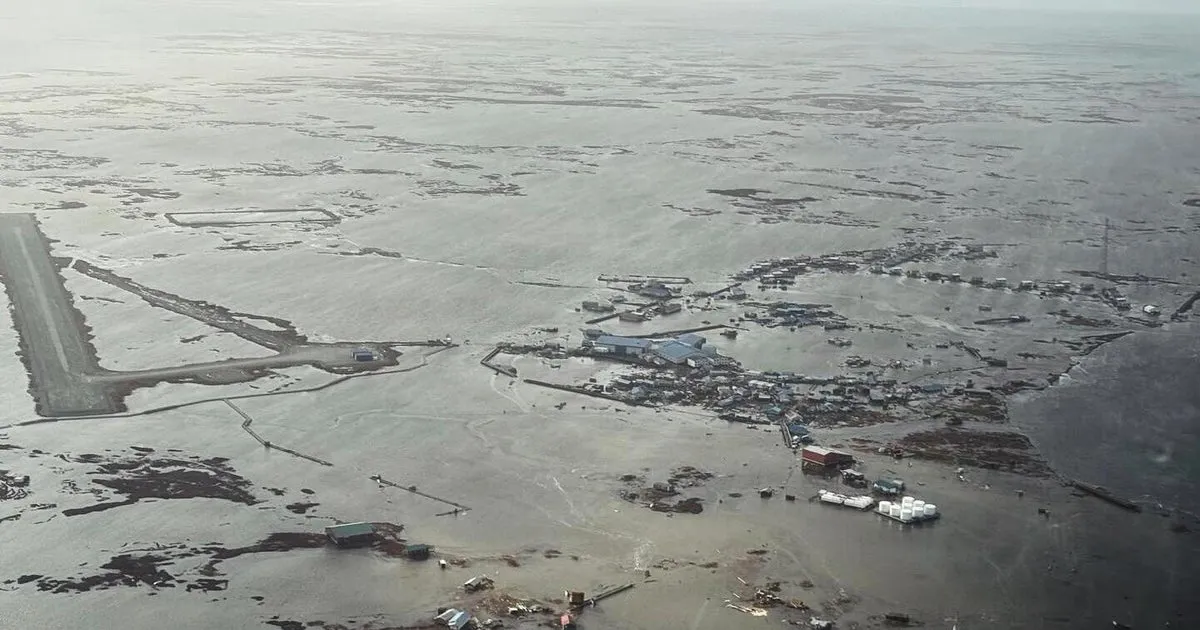
On Wednesday, one of the most significant airlifts in Alaska's history commenced to evacuate hundreds of individuals from coastal villages devastated by high surf and powerful winds resulting from the remnants of Typhoon Halong over the weekend. Officials reported that the storm caused record water levels in two low-lying communities, leading to the destruction of homes—some with people still inside.
In response to the crisis, makeshift shelters were rapidly established, accommodating approximately 1,500 people—an extraordinary figure for a sparsely populated region primarily accessible by air or water. According to Jeremy Zidek, spokesperson for the Alaska Division of Homeland Security and Emergency Management, a tragic incident occurred where one person was rescued while two others remain missing after a home was swept out to sea. “There were homes washed out to sea, and unfortunately, there was one home which was occupied, and three people were washed out,” Zidek explained. “One person has been recovered, and two persons are still missing. That's the most devastating impact.”
Approximately 300 evacuees are being transported to Anchorage, located about 500 miles east of the affected coastline. The Alaska Department of Military and Veterans Affairs reported that some evacuees are being directed to a temporary shelter at the Alaska Airlines Center, a major arena in Anchorage. The remoteness of the impacted areas, combined with the scale of destruction, has made it challenging to mobilize resources effectively. Damage assessments have been gradually coming in, as responders transition from initial search-and-rescue operations to stabilizing and restoring basic services.
The storm struck on Saturday evening, and by Sunday morning, Zidek noted that the Alaska National Guard and State Troopers had launched aircraft to reach the communities, performing heroic rescues. “They were literally plucking people off roofs, going into homes, helping people wade out of the water, and lifting them in baskets to bring them to safety,” he added.
The coastal communities of Kipnuk and Kwigillingok, located near the Bering Sea, experienced water levels exceeding six feet above the highest normal tide line. Emergency management officials have indicated that some homes are not safe for reoccupation, even with emergency repairs, and others may remain uninhabitable as winter approaches. Forecasters are predicting potential rain and snow in the region this weekend, with average temperatures expected to drop below freezing.
Mark Roberts, the incident commander with the state emergency management agency, emphasized the immediate priority is to ensure that evacuees are safe, warm, and cared for. “While we work with our partners to restore essential services, we must focus on the well-being of those affected,” Roberts stated. In Kwigillingok, where around 350 individuals sought refuge overnight on Tuesday, restroom facilities at the local school have been restored, as reported by state emergency management officials.
With shelter spaces in the southwest Alaska regional hub of Bethel reaching capacity, authorities are actively seeking additional locations to accommodate evacuees. Zidek mentioned that the timeline for the evacuation process remains uncertain. “The aim is to transition people from congregate shelters into hotel rooms or dormitories,” he said. He further highlighted the extreme remoteness of the communities, explaining, “There are no roads to any of them. The only reliable way to get in and out of them is by air, and storms can make that impossible for extended periods.”
The unfolding crisis in southwest Alaska has drawn attention to cuts made during the Trump administration to grants that were designed to assist small, primarily Indigenous villages in preparing for storms and mitigating disaster risks. For instance, a $20 million grant from the U.S. Environmental Protection Agency aimed at protecting Kipnuk from flooding was terminated, a decision that has faced challenges from environmental groups.
This grant was intended to safeguard the boardwalk utilized by residents and protect 1,400 feet of riverbank from erosion, according to a federal spending tracking website. Limited progress was made on the project before the grant was cut. The village had even purchased a bulldozer for shipment and briefly hired a bookkeeper, as reported by the Public Rights Project, which represents Kipnuk. While no single project could have completely prevented the recent flooding, efforts to remove abandoned fuel tanks could have been undertaken in the 2025 construction season.
Jill Habig, CEO of the Public Rights Project, stated, “What’s happening in Kipnuk illustrates the real cost of withdrawing promised support from frontline communities. These grants were designed to help local governments prepare for and adapt to the growing effects of climate change. When that commitment is broken, it jeopardizes people’s safety, homes, and futures.”